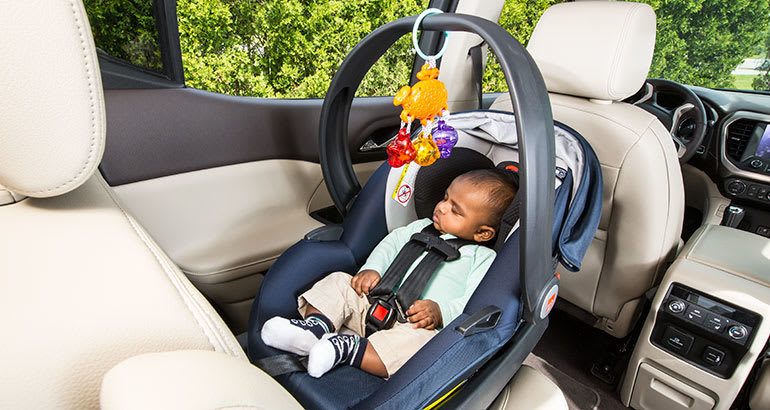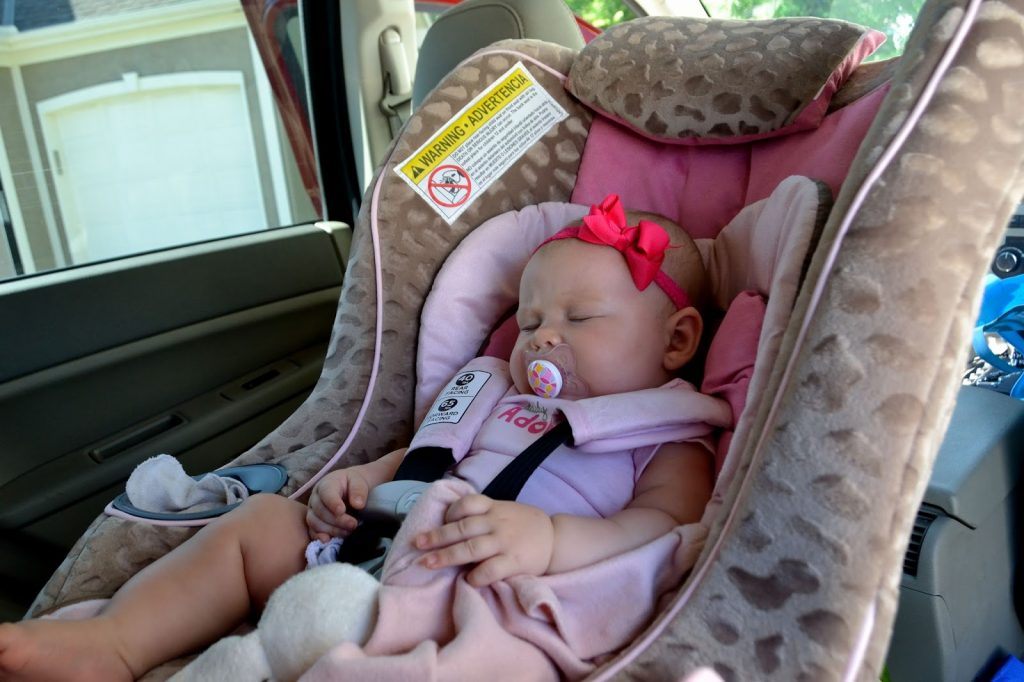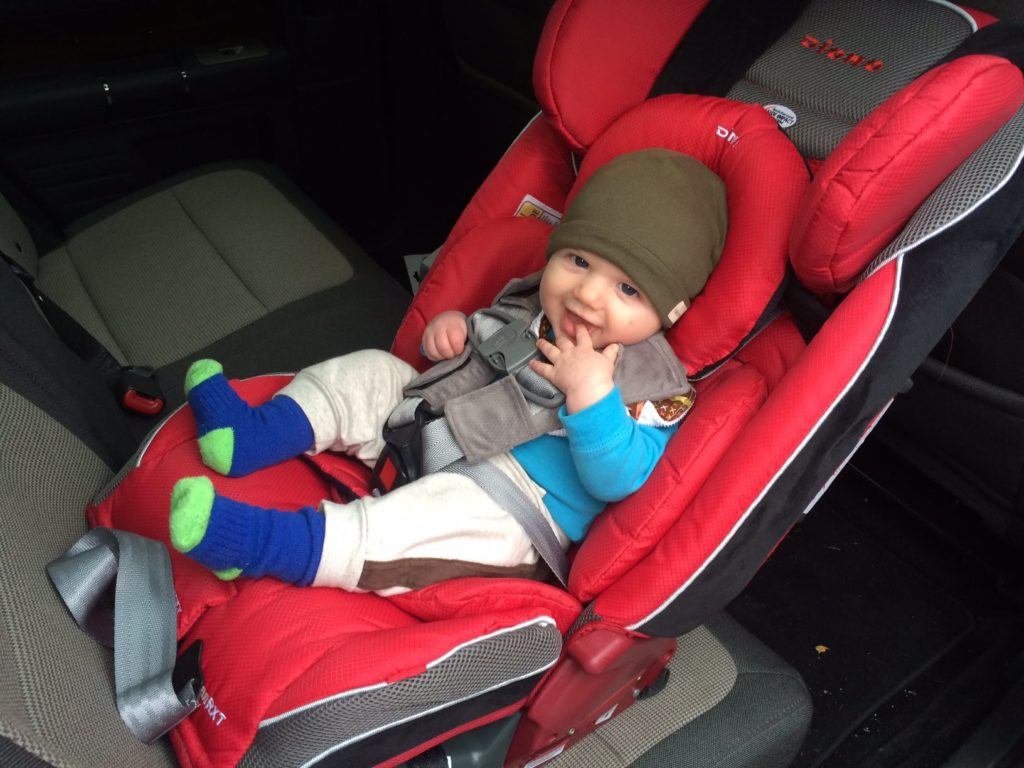As parents, we can’t stop talking about our worst fears, like SIDS.
The harsh reality is that car crashes are the #1 cause of death in children.

In 2018 alone, over 97,000 kids (aged 12 or younger) were injured in traffic crashes, and 636 of them tragically died.
Even using the word “death” in the same sentence as “kids” makes my skin crawl.
But the only thing worse than talking about it is not talking about it.
So, today, I’ll do the latter – I’ll talk about it.
I’ll focus on the things you can do and the all-important 2-hour car seat rule.
How long can a baby stay in the car seat on long journeys?
Let’s start here – at the newborn stage, rear-facing car seats are mandatory.
Full stop, end of that part of the safety story, no buts, no what-ifs.
Let’s move on.
Below are some of the safety points that a parent needs to consider when driving around a newborn.
Follow the two-hour car seat rule
Car seat companies recommend that a baby only sits for two hours in a car seat within a 24h timeframe – parents will know this as the 2-hour rule.
If this is the first time you hear about it, don’t fret, we’ll go over everything you need to know about it.
What age does the 2 hour car seat rule end?
The 2-hour car seat rule age is not specific, but it should be followed until the baby is at a phase to sit upright and control their head and neck movement.
When can a baby be in a car seat longer than 2 hours?
Sitting upright and having complete control of the head and neck is a sign that your baby can be in a car seat for longer than 2 hours. These guidelines are updated for 2020 and 2021.
Bottom line – if your question is, “At what age does the 2-hour car seat rule end?” The answer to that is more about the baby’s ability to sit correctly than age.
That especially goes if you have a prematurely born baby. In this scenario, you might think about choosing a car seat that meets the needs of a preemie (you can see my top picks of car seats for preemies here).
Buy the appropriate car seat
There are different types of car seats in the market. They are designed to be age, weight, and height specific.
Again, a suitable car seat is rear-facing. Read more on my choices of the best car seats for small cars here.
How long should I keep my child in a rear-facing car seat?
For at least two years, according to the AAP guidelines.
Choosing the car seat
Make sure that your brand of choice meets or exceeds the standards set by the CDC (you can see an outline here).
If you’re going with a used car seat, ask the previous owner how long it has been used before it got to you.

Also, check the seat’s expiration date as recommended by the manufacturer, and when in doubt, call them to confirm if it is ideal for your newborn or not — child seats with missing parts or those with signs of wear and tear are to be avoided.
Typically, you’ll need the registration card that comes with the product and provide accurate information to make sure you’re notified in case of a recall. Don’t let nonsense like sharing your information lead you into giving them false info, like an email or phone number.
The baby gear companies will not track you.
And if they do, they won’t learn much about you from the daily trips to Carter’s.
Relax.
Moving on.
Installation and positioning
A car seat must be installed correctly (duh).
The user manual that accompanies the seats outlines the installation steps.
Other than the guidebook, parents and caregivers are expected to attend a safety class when practical demonstrations on setting up a car seat are provided.
Consult an expert
An expert can be consulted once the car seat has been installed to certify that it is in the correct position. The ideal spot to place an infant-only car seat is the middle of the back seat.
This rule can be altered if the car seat does not fit in this spot securely. The child restraint seat should, however, remain in the back seat. Not more than an inch of movement should be allowed in any direction.
Putting your baby in the car seat
Once the seat has been installed correctly, the child can be put in. Infant seats come with a five-point harness that must be tightly strapped over the baby.
The straps and clips must lie flat on the baby for maximum safety. Also, the baby should be in comfortable clothes that allow the straps in the crotch area to snap into place correctly.
Finally, the baby should be covered over the secured straps and not under.
Their head and neck
The infant car seat in use must be reclined at an angle set by the manufacturers to keep the baby’s head from flopping forward. It’s because newborns have no control of their head and neck movements.
The baby should always ride in a semi-reclined position to ensure that their airways are clear. Always use the angle indicators and adjusters to make sure that the baby is in the right place.

Babies with acid reflux are especially sensitive to the position and their parents are sensitive to cleaning the vomit. Alas, sometimes the accidents are simply unavoidable.
In those situations, a good seat protector will be a life-saver (you can see my top car-seat protectors picks here).
Reclined vs. straight
The semi-reclined position, although recommended, is not ideal for a newborn baby.
Restricted airflow to the baby’s lungs may cause respiratory problems, especially when they fall asleep while in the infant car seat. The baby’s developing spine will also strain, and if the car seat is used regularly and for long hours, it may lead to severe damage.
Avoid long journeys
Parents and caregivers are advised to avoid planning long trips until their baby is ready to withstand traveling for long hours. Besides long-distance travel, traffic in your city must be factored in to keep away from being stuck in one with a newborn baby in the car.

When long journeys are unavoidable, breaks should be scheduled between hours to give the infant child a chance to relax before proceeding with the trip.
These are all common-sense tips, but you’d be surprised by how many parents shrug things like this off.
Bottom line
Lie flat car seats are an alternative solution to driving around with a newborn. If you have a car that can fit this type of baby car seat, getting it is a no-brainer.
Finally, remember that infant car seats should only be used in the vehicle.
For more curious facts about car seats, find out if your car seats floats and what to do with an old car seat when you’re done with it.

Steph is a passionate mom who co-founded Wumblers to share her parenting journey with others. She graduated from Concordia University with a masters degree in Education Technology and worked as an advisor for many years. Steph loves being a mom and wants to have more kids.
Learn more about Steph and Wumblers here.